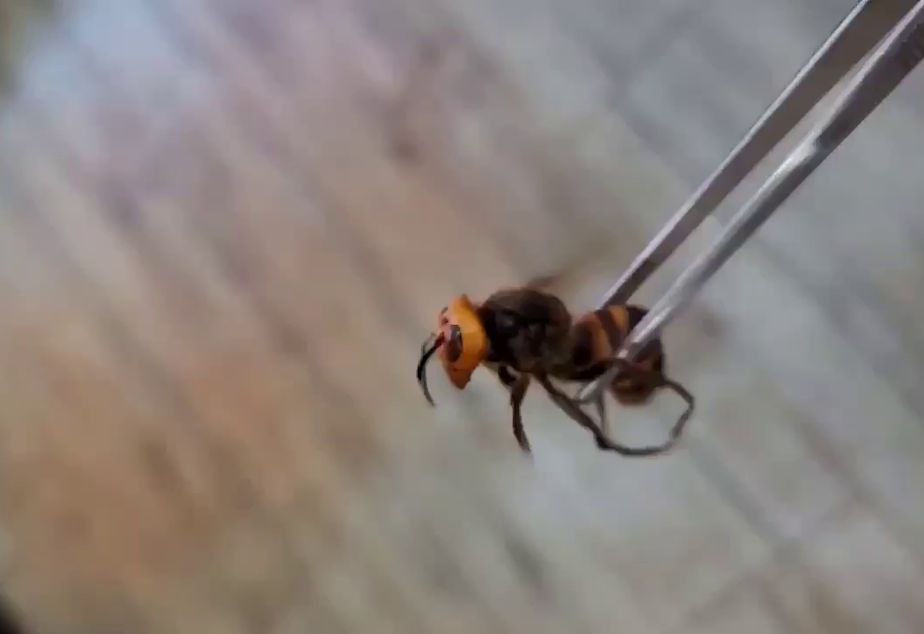All quiet on the Northwestern giant hornet front (so far)

 11 secs
A captured northern giant hornet, sounding more like a hedge trimmer than an insect, flaps its wings in Uiseong, South Korea, in October 2022.
11 secs
A captured northern giant hornet, sounding more like a hedge trimmer than an insect, flaps its wings in Uiseong, South Korea, in October 2022.
No northern giant hornets have turned up in Washington state so far this year, according to Washington agriculture officials.
Nearly 1,000 orange-juice-filled traps have been deployed since July, mostly in Whatcom County, near the Canada border, in hopes of detecting northern giant hornets before any of the unwelcome invaders can reproduce or spread to new territory.
“Our trapping teams haven't found any hornets this year yet, but the season is not over,” Washington state Department of Agriculture spokesperson Amber Betts said in an email.
Efforts to trap the the invasive hornet — the world’s largest — are planned to continue until the end of November.
U.S. and Canadian officials have been on high alert for the stinging invader since one was first spotted on Canada’s Vancouver Island in 2019.
The notorious hornets, sometimes called "murder hornets," are viewed as a major threat to the honeybees that pollinate major food crops. Giant hornets can wipe out a honeybee hive in a matter of hours. They use their mandibles to decapitate bees and feed honeybee thoraxes to their young.
Concerned citizens in almost every county in Washington have reported seeing what they thought were northern giant hornets in 2023. State entomologists say every report that included a photo turned out to be a wasp, sawfly, or some smaller species of hornet. Reports without photos could not be confirmed or refuted.
There have been no confirmed sightings of northern giant hornets in North America since the summer of 2021, when insect specialists found and destroyed three nests near Blaine, Washington, on the Canadian border.
In 2022 and so far in 2023, hornet traps in Washington and British Columbia have come up empty.
Research continues on both sides of the Pacific Ocean on how to attract and locate the apex predators known to scientists as Vespa mandarinia.
Hornet traps are typically filled with orange juice and rice wine, though the fruity smell can attract many different insects, even beneficial ones.
Kyungpook National University researcher Choi Moon-Bo has been working with Washington-based researchers to study the hornets in their native habitat in South Korea.
The hornets’ native range covers a broad swath of Asia from India to the Russian Far East.
Efforts to use the hornets’ own pheromones as lures have proven unsuccessful to date, Choi said in an email.
“In the pheromone attraction experiment, there was no response from mandarinia at all,” Choi said.
Studies to document how far the hornets can travel under their own power have encountered difficulties as well.
“The micro tags are too heavy for the hornets to carry and fly, making their activities unnatural,” Choi said. “We plan to receive a lighter tag and conduct another experiment next year.”
It is unknown how the insect arrived on North American shores, though it is thought to have arrived on a cargo ship.
“North America ports continue to be likely entry points of Vespa species in the future,” Paul van Westendorp with the British Columbia Ministry of Agriculture, Food and Fisheries said in an email.
A nest of yellow-legged hornets, a much smaller but more aggressive species of bee-eating hornet from Southeast Asia, was found and destroyed near Savannah, Georgia, in September.
Under U.S. Department of Agriculture rules, the northern giant hornet won’t be considered eradicated until three years have passed with no detection of it.
British Columbia declared Vancouver Island and the neighboring Gulf Islands giant-hornet-free in 2022 after two years with no local sightings.
Two years is sufficient for a conspicuous apex predator like the northern giant hornet, according to van Westendorp, the province’s top hornet expert.
“While plant-feeding pests may be unobserved for a number of years, the predatory nature of NGH [northern giant hornets] and their communal nesting behavior make their presence inevitably observable,” van Westendorp said.

